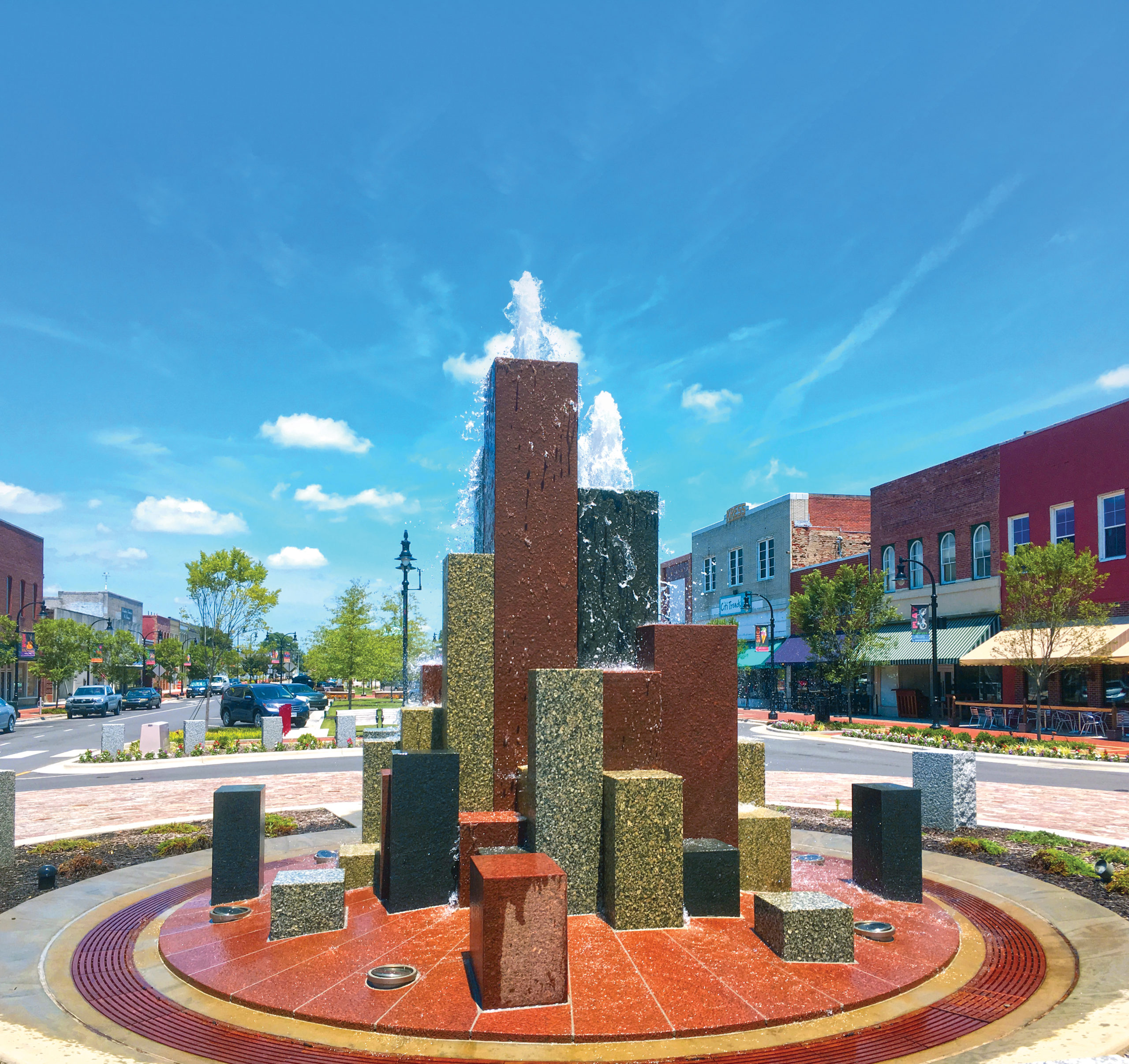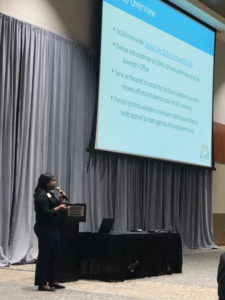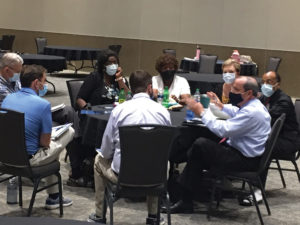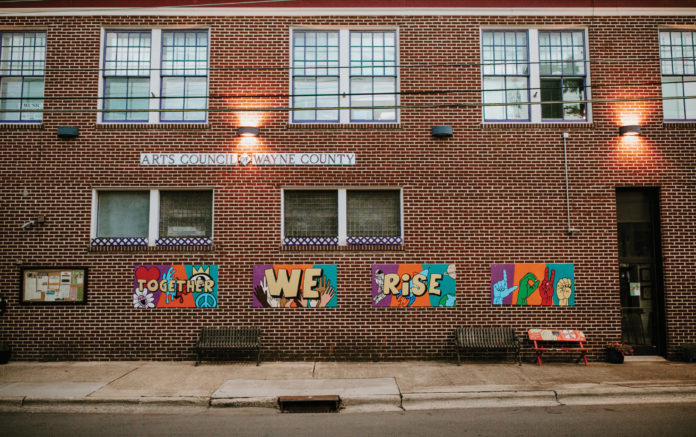Never before has money flowed directly to our cities and towns like it has with ARP. How will the money be used? How should the money be used?
In early August 2021, leaders from Wayne County and its seven municipalities gathered to discuss the American Rescue Plan. On this day, the topic was priorities.
American Rescue Plan, or ARP, questions will land in one of four areas: How to get the money, how to legally spend the money, how to choose what to spend on, and how to account and record those expenditures. The first category has nearly concluded, with all metropolitan cities in North Carolina having received their first tranche of funds (the second tranche, which will equal the first tranche and conclude all ARP local appropriations, is to be sent one year after the first). All non-metro cities and towns are receiving their funds through the state, and as of late September, nearly all municipalities had been sent their allotment.
As for reporting and accounting, the U.S. Treasury has published detailed interim guidance and resources. While no small undertaking for the capacity of North Carolina’s municipalities, the requirements and deadlines are clear.
The other two areas—and perhaps the most critical of all—continue to evolve. As of press time, Treasury has offered interim guidance, and continues to revise and clarify many of its key points. North Carolina’s House, Senate, and Governor have all addressed ARP in their respective versions of the state budget—with Governor Cooper proposing that the state match ARP funds in select expenditure categories—but the budget process remains incomplete.
NCLM President Karen Alexander published a letter to League membership over the summer, urging cities and towns to “hurry up and wait.” That is, to hurry up to determine priorities and capacity, and then wait to see how the final guidance and state budget shake out. “Undoubtedly and understandably, the impulse is to spend this money on immediate needs and move quickly to make decisions,” Alexander wrote. ”Our message, however, is the opposite. We urge patience and prudence.”
The level of uncertainty on how to proceed is understandable. This is new territory. Despite the steady flow of federal resources and aid during the COVID-19 pandemic, the ARP marks the first time that cities and towns will receive support directly. It is intended for recovery. It is also intended for transformational, generational local investment.
So, how will it be used? How should it be used?
Background
It’s important to remember how this all came about. Since March 2020, cities and towns across North Carolina have dealt with a financial crisis caused by no action of their own, but rather by a deadly, global pandemic. Health measures, lockdowns, an inability to gather—these consequences of COVID-19 produced an economic fallout that has impacted all areas of our state. Thread through every cancelled event and empty street is a story of financial hardship, for residents, business owners, and local governments alike.
Cities’ and towns’ coffers rely heavily on sales tax and occupancy tax—two revenue sources that were hit the hardest by the pandemic. As health precautions and rising unemployment hindered normal economic activity, less money changed hands, and less sales tax was collected; travel and tourism severely diminished, and less occupancy tax was collected.
This revenue is not excess. It is critical, and used to provide the key public services that our residents rely on: public safety, infrastructure, water, and more. As our citizens struggled through the pandemic, our municipalities suffered as a result. And as our municipalities suffered, our citizens were harmed even more.
ARP is designed to promote recovery through investment. As such, it’s a rare opportunity for North Carolina.
Where can the money be spent?
When referring to the “American Rescue Plan,” the circles of local government are most often referring to the direct funding to cities and towns, known formally as the Coronavirus State and Local Fiscal Recovery Funds. In North Carolina, this totals $5.2 billion for the state, $2 billion for the counties, and $1.3 billion for the municipalities.
It is not simply do-as-you-wish funding. First and foremost, it is relief—to local budgets, to essential workers, and to the ongoing COVID-19 situation. That intention is expressed through the law’s four allowable expense categories for local governments: Responding to the public health emergency or its negative economic impacts; premium pay to eligible essential workers; replacement of lost revenue due to COVID-19 emergency; and water, sewer, or broadband infrastructure.
Second, it is notable that the funds to local governments nationwide make up only a small portion of the overall act—$360 billion of the overall $1.9 trillion law. The American Rescue Plan additionally includes relief funding to restaurants, small businesses, entertainment venues, schools and child care providers, and supports rental assistance and expanded unemployment, as well as support for certain types of employees (including transportation workers and health care workers).
“As we think about being deliberate, planning these funds and thinking about the ways they could be most effectively deployed, it’s important to be aware of what other funding and assistance is out there and that sectors of your community can tap into before you spend your fiscal recovery funds in those areas,” said NCLM Director of Research and Strategy Chris Nida. “It will allow you to think more strategically and more transformationally.”
With those boundaries and other sources of support in mind, discussions of ARP possibilities usually spur the same few questions: What is the most important thing I can address, what is a one-time expense, and what is the investment that will yield the greatest long-term impact?
The municipal leaders of Wayne County contended with the same questions. And in near-unanimous agreement, they turned towards infrastructure.

Where should the money be spent?
Local leaders know their communities best. There is no one answer to the question of how best to utilize ARP support. However, when looking at the small sample size of a single county—Wayne County—the takeaway is that the needs of the state match the needs of the towns: water infrastructure.
In 2017, the State Water Infrastructure Authority published “North Carolina’s Statewide Water and Wastewater Infrastructure Master Plan: The Road to Viability,” and estimated the required investment across the state to be in the tens of billions.
“Over the next 20 years, capital cost estimates for water and wastewater system needs in North Carolina range from $17 to $26 billion—most likely at the higher end of the range,” wrote Francine Durso and Kim Colson, respectively the then-senior project manager and then-director of the N.C. Division of Water Infrastructure, in a guest article in a 2019 issue of Southern City. “While subsidized loans are the primary vehicle to help make infrastructure more affordable, (we) recognize that only a fraction of today’s infrastructure capital needs can be met with currently available state or federal subsidized funding levels.” The ARP, however, changes that calculus.
With representatives from all of the area’s local governments—from Goldsboro to Eureka—more than 95% of attendees reported beforehand that water and wastewater infrastructure was the top need. At the workshop itself, leaders both elected and appointed echoed those sentiments throughout. Infrastructure was deteriorating and capacity needed expanding—and investment and partnership opportunities were now very possible due to ARP funding. The top priority was clear.

Another reason for the attraction to infrastructure is the potential for matching state funds. This policy was included in Governor Roy Cooper’s proposed state budget, and was reiterated by the Governor when he spoke to League membership during a July webinar. “These capital, one-time infrastructure investments are so important,” Governor Cooper said. “We want you to be able to leverage those resources to get the most that you can for your people.”
(As of late September, no state budget has been passed. Please stay tuned to NCLM’s weekly legislative bulletin for updates.)
More than anything, though, the draw to this spending category seems to be due to how it meets the agreed-upon criteria for spending choices: it is a one-time expense, and it is transformational. That’s a target used by federal, state, and local leaders alike. And it’s at the heart of what cities and towns do for their communities—they build.
“I’ve been in public service a long time,” Governor Cooper said. “I’ve never seen this much available funding that can be invested in our communities for transformational change.”
While undisputed in Wayne County, some cities have highlighted other priorities. The City of Durham, for example, has published a recovery plan that highlights equity as a top priority, as determined through input from the community. To this end, at least some of the city’s ARP funding is set to go towards premium pay, which will provide a one-time bonus rewarding essential workers for the risks they took throughout the COVID-19 pandemic. Through Durham’s process too, though, the result is good answers to the right questions: What is the most important thing I can address, what is a one-time expense, and what is the investment that will yield the greatest long-term impact?

Resources
The quantity of available resources, consultative services, educational events and workshops is substantial: the N.C. League has a dedicated website, arp.nclm.org; the state’s N.C. Pandemic Recovery Office has a video series, fact sheets, templates, and more; and the UNC School of Government is hosting weekly call-in sessions where experts can help answer questions for local leaders.
As the ARP process continues, the League will continue to serve as your go-to resource. Services are being developed to help with consultative services, partnership facilitation and, perhaps most important, accounting and reporting of ARP funds. The blog at arp.nclm.org tracks all developments, and our weekly newsletter, League Letter, shares each new addition or update to the site. Stay tuned for upcoming workshops in your county or region.
We also are proud to support our partners, NC PRO and the UNC School of Government, who have created a series of resources and events that allow local leaders to get answers to their most pressing questions.
Lastly, we want to hear from you. Questions, concerns, and otherwise, please
feel free to reach out to us for help at arp@nclm.org.













